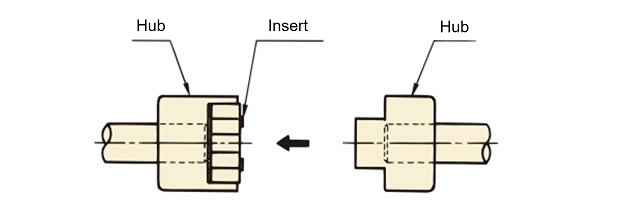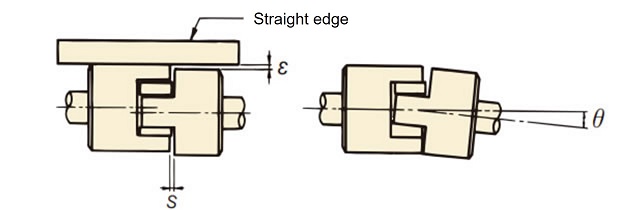Technical Data Coupling Handling
Jaw-flex Couplings L Series Handling
With plain bore
1. Bore machining, keyway machining
Follow the procedure below when machining bore or keyways in pilot bore models.
- (1) Before machining, chuck the hub outer circumference and center the hub as shown in Figure 1.
Sintered hub types and plated hub types are made of steam-treated ferrous sintered alloy, so use of a cutting tool made of ultrahard material (JIS symbols 9-20, K-01) is recommended. (Models L190 and L225 are cast iron. ) - (2) Keyways should be machined at positions out of the way of claws. The tap sizes and positions shown in Table 4 are recommended.
- (3) The recommended bore machining tolerances are clearance fit tolerances such as those shown in Table 5. Avoid tight fits and attachment methods generating internal tensile stress such as Power-Locks.
Fig. 1.Bore machining

| Fit | Fit | Fit | |||
|---|---|---|---|---|---|
| Shaft tolerance | Hole tolerance | Shaft tolerance | Hole tolerance | Shaft tolerance | Hole tolerance |
| h6 h7 |
H7 | j6 j7 |
G7 | k6 k7 |
F7 |
| Sintered hub type, plated hub type | Aluminum hub type | |||||||||||||||||||
|---|---|---|---|---|---|---|---|---|---|---|---|---|---|---|---|---|---|---|---|---|
| Size | L035 | L050 | L070 | L075 | L090 | L095 | L099 | L100 | L110 | L150 | L190 | L225 | L050A | L070A | L075A | L090A | L095A | L100A | L110A | |
| L035F | L050F | L070F | L075F | L090F | L095F | L099F | L100F | L110F | L150F | L190F | L225F | |||||||||
| Tap size | M3 | M4 | M5 | M5 | M6 | M6 | M6 | M6 | M8 | M8 | M8 | M8 | M4 | M5 | M5 | M6 | M6 | M6 | M8 | |
| F(mm) | 3.0 | 8.00 | 9.5 | 10.5 | 10.5 | 12.5 | 13.5 | 12.5 | 20.5 | 17.5 | 25.5 | 25.5 | 8.0 | 9.5 | 10.5 | 10.5 | 10.5 | 17.0 | 20.5 | |
2. Mounting
- (1)Fit the hubs and keys onto both shafts. Do not hammer in the hubs or keys. Keys should be well ground.
- (2) Fasten the two set screws.
- (3) Fit the insert into one of the hubs.
- (4) Insert the insert so that the claw end surface of both hubs will be flush with the insert end surface. (Fig. 2)
- (5) Correct the angular misalignment by setting the S dimension (given in Table 6) uniformly around the circumference as shown in Figure 3. See Table 6 for the allowable angular misalignment θ.
- (6) Place a straight edge on the outer circumference of the hubs as shown in Figure 3, and adjust dimension ε to no more than the value shown in Table 6, at two points separated by about 90 degrees. Insert wear life is greatly affected by the centering alignment.
Fig. 2

Fig. 3. Centering

| Size | Sintered hub | L035 | L050 | L070 | L075 | L090 | L095 | L099 | L100 | L110 | L150 | L190 | L225 |
|---|---|---|---|---|---|---|---|---|---|---|---|---|---|
| Plated | L035F | L050F | L070F | L075F | L090F | L095F | L099F | L100F | L110F | L150F | L190F | L225F | |
| Aluminum hub | L050A | L070A | L075A | L090A | L095A | L100A | L110A | ||||||
| Allowable parallel misalignment (Parallel Misalignment )ε(mm) | 0.38 | 0.38 | 0.38 | 0.38 | 0.38 | 0.38 | 0.38 | 0.38 | 0.38 | 0.38 | 0.38 | 0.38 | |
| Allowable angular misalignment (Angular Misalignment )(θ°) | S/M types | 1 | 1 | 1 | 1 | 1 | 1 | 1 | 1 | 1 | 1 | 1 | 1 |
| H Type | 0.5 | 0.5 | 0.5 | 0.5 | 0.5 | 0.5 | 0.5 | 0.5 | 0.5 | 0.5 | 0.5 | 0.5 | |
| S(mm) | Standard dimension | 0.6 | 1.9 | 1.7 | 1.7 | 1.7 | 1.7 | 1.7 | 1.9 | 2.3 | 2.0 | 2.3 | 2.3 |
| End play (Axial Displacement ) | ±0.3 | ±0.5 | ±0.5 | ±0.5 | ±0.5 | ±0.5 | ±0.5 | ±0.7 | ±0.7 | ±0.7 | ±1.0 | ±1.0 | |
※M type and H type with aluminum hub can be used, but have the same transmitted torque as the S type.
- (7) When the rotation speed will exceed 2,000 r/min, reducing the ε and θ values shown in Table 6 by at least half is recommended.
- (8) Another mounting method is to move the hubs along the shafts to make the claw and insert end surfaces flush in both hubs as shown in Figure 4. When using this method, perform centering by the same method of Steps (5) and (6). After centering, fasten the two set screws tightly, applying the tightening torque given in Table 7 below.
- (9) To prevent the set screws becoming loose, use of a metal adhesive is recommended
(recommended type :Loctite 262 )
Fig. 4

| Set Screw Size | M3 | M4 | M5 | M6 | M8 | M10 | M12 |
|---|---|---|---|---|---|---|---|
| Tightening torque N・m{kgf・m} |
0.78 {0.08} |
1.86 {0.19} |
3.63 {0.37} |
6.66 {0.68} |
16.2 {1.65} |
29.4 {3.0 } |
54.9 {5.6 } |
Hubs with machined bore
1. Items to check before mounting
- (1) The hubs display the bore diameter and key type (J: New JIS key, normal type; E: Old JIS key, Type 2), so check the bore diameter and key type for the ordered size.
- (2) Two set screws are provided.
- (3) Hubs with bore diameters of 11 mm or less have no keyway, so are mounted using the two set screws.
- (4) Check that the shaft tolerance of the shafts to which the hubs are mounted is the recommended tolerance shown in Table 8.
| Fit | Fit | Fit | |||
|---|---|---|---|---|---|
| Shaft tolerance | Hole tolerance | Shaft tolerance | Hole tolerance | Shaft tolerance | Hole tolerance |
| h6 h7 |
H7 | j6 j7 |
G7 | k6 k7 |
+ 0.040 + 0.015 |
2. Mounting
See the mounting procedure for pilot bore products on the above.
3. Operating environment
- ・Use the couplings in a well-ventilated location with low humidity and dust.
- ・Avoid use in locations having corrosive liquids or gases, or locations of possible fires or explosions.
- ・Avoid outdoor use.
4. Inspection
After operating the equipment for one or two hours, check the angular misalignment and the parallel misalignment once again.
Also check for problem parts and insert wear periodically (such as every six months to one year).
Inserts are consumable parts that should be replaced regularly.

